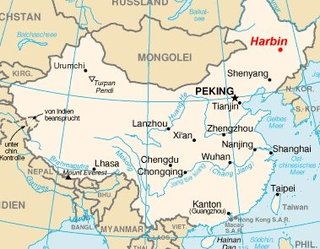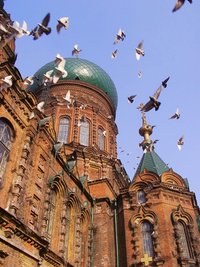Harbin
|
|
Harbin (Template:Zh-stpw; Russian Харби́н Kharbin) is a sub-provincial city in north-east China and the capital of the Heilongjiang Province. It lies on the southern bank of Songhua River. Harbin is a thriving industrial city. It is also the political, economic, scientific, cultural and communications mecca of Northeast China. Harbin is known as one of the major cities in China and Northeast Asia.
- City seat: Daoli District
- Population: 9,410,000 (as of 2001)
- Area: 53775 km², 1637 km² urban
- Geographic coordinates: 125°42′-130°10′ east, 44°04′-46°40′ N
- GDP: ¥141.48 billion (ca. US$17.149 billion) in 2004, ranked no.17 on total GDP and no.29 on GDP per capital among Chinese cities
- Competitive Ability: Ranked no.10 in <2004 Chinese City Competitive Ability Reports>
- Mayor: Shi Zhongxin (石忠信): since 2002
Harbin bears the nickname 'The Pearl on the swan's neck' because the shape of Heilongjiang resembles a swan. 'Oriental Moscow' or 'Oriental Paris' for the architecture in the city. Also is known as 'Ice City' for its long and cold winter.
| Contents |
Subdivisions
Harbinblue.jpg
8 districts:
- Daoli (道里区)
- Nangang (南岗区)
- Dongli (动力区)
- Pingfang (平房区)
- Xiangfang (香坊区)
- Daowai (道外区)
- Songbei (松北区)
- Hulan (呼兰区)
4 county-level cities:
7 counties:
- Fangzheng (方正县)
- Bin (宾县)
- Yilan (依兰县)
- Bayan County (巴彦县)
- Tonghe (通河县)
- Mulan (木兰县)
- Yanshou (延寿县)
History
Human settlement in the Harbin area dates from at least 2200 BC (late Stone Age). It is formerly Pinkiang.
The modern city of Harbin originated in 1898 with the construction of the Chinese Eastern Railway by Russia.
Following the Russian defeat in the Russian-Japanese War (1904-5), Russia's influence declined, and 160,000 nationals from 33 countries including the United States, Germany, and France moved to Harbin. Sixteen countries established consulates and set up several thousand industrial, commercial and banking companies in Harbin. The Chinese also established their own businesses in brewing, foodstuffs and the textile industry. Harbin had established its status as the center of northeastern China and as an international metropolis.
In December 1918, during the Russian Civil War, Russian White Guards, with Chinese assistance, took the city: it then became a major centre of a large Jewish Community and White Russian émigrés.
Japanese troops occupied Harbin from February 4, 1932. The Soviet Army took the city on 20 August 1945. After a period under the control of the Kuomintang, the city came into the hands of the Chinese People's Liberation Army in April 1946.
The eight Harbin counties originally formed part of Songhuajiang Prefecture (松花江地区), and became incorporated into Harbin on August 11, 1999, making Harbin a sub-provincial city.
City Architecture
Called the Oriental Moscow, Harbin is one of China's more beautiful cities. The city is well-known for its unique, Russian-influenced architecture.
Zhong Yang Street (Central Street), one of the main business streets in Harbin, is a perfect remnant of the bustling international business activities at the turn of the 20th century. The 1.4km long street is a veritable museum of European architectural styles, including Baroque and Byzantine façades, Jewish architectural wonders, little Russian bakeries, French fashion houses, American snack food outlets, Japanese restaurants, and a Russian Orthodox church: St. Sophia Cathedral.
St. Sophia took nine years to build and was completed in 1932. It has now been made into a museum as a showcase of the multi-cultural architecture of Harbin.
Many citizens believe that the Orthodox church damaged the local feng shui, so they donated money to build a Chinese monastery in 1921, the Ji Le Temple. There were more than 50 churches in Harbin until 1949. Mao's Communist Revolution, and the subsequent Cultural Revolution, saw several of them destroyed. Now, about 20 churches remain.
Russian Influence
Harbin today is still very much influenced by its Russian past. A city once under Russian rule, it is now a center of trade with that country.
It is a trading post, where goods from Russia are available. For some Chinese people, Harbin is the only place to go to acquire traditionally Russian products such as vodka, and Russian memorabilia such as Matryoshka dolls.
The diet in Harbin is also Russian-influenced. Harbin's bakeries are famous, and produce bread that is better than most bread available elsewhere in China. Harbin's sausages are another notable product, in that they tend to be of a much more European flavour than other Chinese sausages.
Winter Culture and Activities
Ice_Snow_World.jpg
Harbin is one of the sources of ice and snow culture in the world. Geographically, it is located in Northeast China under the direct influence of the cold winter wind from Siberia. The average temperature in summer is 21.2 degrees Celsius, -16.8 degrees Celsius in winter. It can be as cold as - 38.1 degrees Celsius in winter.
The annual "Harbin International Ice and Snow Festival" has been held since 1985. It starts from January 5th and lasts one month. There are ice lantern park touring activities held in many parks in the city. Winter activities in the festival include Yabuli Alpine Skiing, winter-swimming in Songhua River, and the ice-lantern exhibition in Zhaolin Garden. Snow carving and ice and snow recreations are world famous.
The "Harbin International Ice and Snow Festival" is one of the world's four largest ice and snow festivals, along with Japan's Sapporo Snow Festival, Canada's Quebec Winter Carnival, and Norway's Ski Festival.
The third Winter Asian Games took place in Harbin in 1996. Harbin was also a bid city for the organization of the 2010 Winter Olympics and will probably try again with the 2014 Winter Olympics. The Alpine skiing events would take place in the Yabuli ski resort. In the frame of this campaign to assert its role on the world scene, Harbin will also be the host city of the 2009 Winter Universiade. Harbin plans to spend US$ 1.5 billion in construction and renovation of its sport infrastructure for this Universiade.
Sister Cities
Domestic
- Chengdu, Sichuan
- Dalian, Liaoning
- Guangzhou, Guangdong
- Hangzhou, Zhejiang
- Wenzhou, Zhejiang
- Xiamen, Fujian
- Xining, Qinghai
International
- Niigata, Japan
- Aarhus, Denmark
- Edmonton, Canada
- Sverdlovsk Oblast, Russia
- Minneapolis, United States
- Ekhurunleni, South Africa
- Daugavpils, Latvia
- Khabarovsk, Russia
- Ploiesti, Romania
- Asahikawa,Japan
- Bucheon, South Korea
- Salvador, Brazil, Brazil
- Givatayim, Israel
Colleges and Universities
- Harbin Institute of Technology
- Harbin University of Science and Technology
- Harbin Polytechnic Institute
See also
External links and resources
External links
- Government website (http://www.harbin.gov.cn/english/index.php) (English)
- Government website (http://www.harbin.gov.cn) (Chinese)
Further reading
Thomas Lahusen. Harbin and Manchuria: Place, Space, and Identity. November 15, 2001. ISBN 0822364751.
Template:Heilongjiangde:Harbin fr:Harbin es:Harbin ja:ハルビン pt:Harbin ro:Harbin zh-cn:哈尔滨


